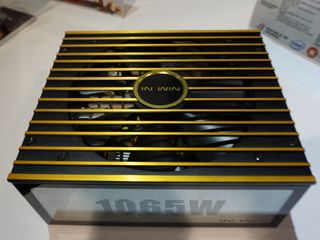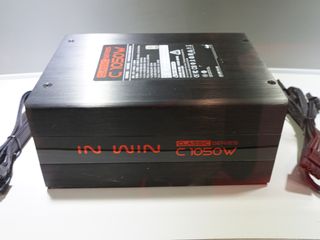In Win Outs H-Frame Case And Limited Edition 1065 W PSU
In Win tries to offer products that easily stand out from the crowd, thanks to their design and looks. At Computex 2015, this company showed us the H-Tower, which looks like a transformer, and this week at CES it showed another new high-end case, the H-Frame.
H-Frame Chassis And Limited Edition PSUs
The H-Frame is by no means as impressive as the H-Tower, but it still looks like they paid extra attention to the smallest detail. Only five hundred H-Frames will be made, and each will be numbered. On top of that, all these cases will be bundled with a specially designed PSU, which has much larger dimensions than the normal ATX form factor PSUs. This means that the Signature PSU with 1065 W capacity will be compatible only with the H-Frame. Therefore, In Win will also make only five hundred Signature PSUs. The estimated price of the H-Frame, including the Signature PSU, will be around $850.

The H-Frame is a full tower chassis supporting E-ATX mainboards along with graphics cards up to 44 cm long (if you only SSDs instead of HDDs). It has eight PCIe expansion slots, and its I/O panel, besides the typical HD audio port, also includes three USB 3.0 ports, along with a single USB 3.1 Type-C port. The case is made of aluminum, and the windowed panel is made of tempered (toughened) glass, something that will protect it from scratches. There is LED lighting, providing a stunning look to the H-Frame, especially in low light conditions.
The model number of the PSU that equips the H-Frame is S11-1065, and besides the increased dimensions (18 cm wide instead of the normal 15 cm), it also features LED lighting along with four different modes of operation, including a mode where the fan continues to spin for a short time after the system's shutdown. There is a USB port at the front side of the PSU that allows you to easily charge mobile devices, without the need for the system to be in operation.

The S11-1065 is fully modular, uses only Japanese capacitors for its internals, and includes all necessary protection features. The cooling fan is 165 mm in diameter, so we expect it to have quiet operation. In Win provides a five-year warranty with this PSU, so it must be quite confident about its reliability.
We should note here that In Win is among very few companies that has a PSU manufacturing line, so its PSU offerings aren't just re-branded products. However, reps told us that the production cost is high, so they have a restricted PSU manufacturing capacity because they cannot compete in this section with the Chinese factories, where the production cost is much lower. They might build fewer PSUs, but when you own a manufacturing line, you can design and build whatever you want -- most important of all, in any quantity. This is why In Win was able to design and build the Signature PSU.

The Classic Series Coming
Besides the special edition Signature PSU, In Win plans to release a new PSU line called the Classic series. There are four members in this lineup, in capacities ranging from 750 W to 1250 W. All use a fully modular cabling design and meet the 80 PLUS Platinum efficiency requirements. The cooling fan has a Hydro Dynamic Bearing and 120 mm diameter, while the chassis is made of aluminum and features an attractive finish.
Stay on the Cutting Edge
Join the experts who read Tom's Hardware for the inside track on enthusiast PC tech news — and have for over 25 years. We'll send breaking news and in-depth reviews of CPUs, GPUs, AI, maker hardware and more straight to your inbox.
MORE: Best Power Supplies
MORE: Power Supplies 101
MORE: How We Test Power Supplies
MORE: All Power Supply Content
Aris Mpitziopoulos is a Contributing Editor for Tom's Hardware, covering Power Supplies. Follow us on Twitter @tomshardware, on Facebook and on Google+.
Aris Mpitziopoulos is a Contributing Editor at Tom's Hardware US, covering PSUs.
-
Darkbreeze So, since they're only making 500 PSUs for 500 cases, I guess when your PSU dies, you throw the case away since it's not a standard form factor and you can't get another one?Reply -
falchard I would have bought the case if it was made a year ago. I went with an InWin 920 case and Corsair PSU. Ran about the same price.Reply -
alidan ReplySo, since they're only making 500 PSUs for 500 cases, I guess when your PSU dies, you throw the case away since it's not a standard form factor and you can't get another one?
lol, no. either you make a braket yourself to make mounting it easier, or you just stick the thin in to as many holes as you have...
i have an old top mounted case, and my current psu didn't really like idea of being up there so i think only 2 screws lined up, i tightened them as much as possible and its been that way for 5 years now. next case i get is going to be horizontal so if this crap happened again, i can toss the psu in there and not worry about it falling down and crushing my build, and i can put whatever cooler i want on it because the load is not on the trying to force itself off. -
turkey3_scratch Why would you need the fans to spin a short time after shut down? It's not like the computer's going to get any hotter.Reply -
blazorthon ReplyWhy would you need the fans to spin a short time after shut down? It's not like the computer's going to get any hotter.
Getting the components down to room temperature quickly may help increase their lifetime slightly. The less time the caps spend being hot at all, the better. -
turkey3_scratch Reply17292309 said:Why would you need the fans to spin a short time after shut down? It's not like the computer's going to get any hotter.
Getting the components down to room temperature quickly may help increase their lifetime slightly. The less time the caps spend being hot at all, the better.
I guess technically, but the 1 minute they probably take to cool down is so small on the grand scheme of things. -
nukemaster When the power is removed on an actively cooled device the temperature actually goes up because the device still has heat and no longer has active cooling. How much depends greatly on the heat output and heatsink size.Reply
With the very low output idle states, most systems do not power down under load anyway.
Other companies have setup systems like this in the past(when all devices ran full speed/voltage all the time) and they never took off as an idea. -
viewtyjoe ReplySo, since they're only making 500 PSUs for 500 cases, I guess when your PSU dies, you throw the case away since it's not a standard form factor and you can't get another one?
I believe another article asked In Win reps and was told that you can mount standard ATX PSUs up to a certain length just fine.
-
Darkbreeze Reply17292061 said:So, since they're only making 500 PSUs for 500 cases, I guess when your PSU dies, you throw the case away since it's not a standard form factor and you can't get another one?
lol, no. either you make a braket yourself to make mounting it easier, or you just stick the thin in to as many holes as you have...
i have an old top mounted case, and my current psu didn't really like idea of being up there so i think only 2 screws lined up, i tightened them as much as possible and its been that way for 5 years now. next case i get is going to be horizontal so if this crap happened again, i can toss the psu in there and not worry about it falling down and crushing my build, and i can put whatever cooler i want on it because the load is not on the trying to force itself off.
Really? You're going to pay this kind of money for a limited edition case, and then later, just pop any old power supply in there hanging by two screws, with a big old gap in between where the original ginormous unit mounted and the edge of the now much smaller unit? Yep, that makes sense to me.
-
Darkbreeze Reply17292578 said:So, since they're only making 500 PSUs for 500 cases, I guess when your PSU dies, you throw the case away since it's not a standard form factor and you can't get another one?
I believe another article asked In Win reps and was told that you can mount standard ATX PSUs up to a certain length just fine.
How would you mount an ATX PSU up to a location that was designed for a larger form factor. Unless the mounting and rear opening on the unit were the same as what is used for a standard ATX unit, in which case, what's the point of having a proprietary unit in there (Which makes no sense anyhow. There's a reason proprietary type hardware has mostly gone the way of the Dodo bird). I guess I just don't see the point of this. I see no advantage or reason to deviate from using a standard form factor power supply. It just doesn't make sense to me. Maybe it's just me.
Most Popular





